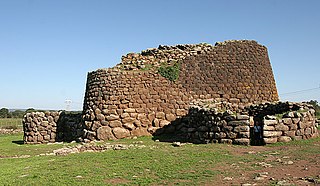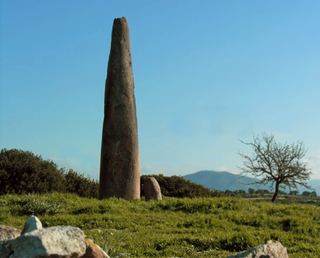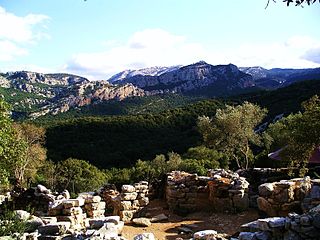
Nuoro is a city and comune (municipality) in central-eastern Sardinia, Italy, situated on the slopes of Mount Ortobene. It is the capital of the province of Nuoro. With a population of 36,347 (2011), it is the sixth-largest city in Sardinia. Its frazione (borough) of Lollove is one of I Borghi più belli d'Italia.

The nuraghe, or nurhag, is the main type of ancient megalithic edifice found in Sardinia, Italy, developed during the Nuragic Age between 1900 and 730 BC. Today it has come to be the symbol of Sardinia and its distinctive culture known as the Nuragic civilization. More than 7,000 nuraghes have been found, though archeologists believe that originally there were more than 10,000.

The Museo Nazionale della Magna Grecia, Museo Archeologico Nazionale di Reggio Calabria or Palazzo Piacentini is a museum in Reggio Calabria, southern Italy, housing an archaeological collection from sites in Magna Graecia.

The Nuragic civilization, also known as the Nuragic culture, was a civilization or culture on the Mediterranean island of Sardinia, Italy, which lasted from the 18th century BC, or from the 23rd century BC, up to the Roman colonization in 238 BC. Others date the culture as lasting at least until the 2nd century AD, and in some areas, namely the Barbagia, to the 6th century AD, or possibly even to the 11th century AD.
The Ozieri culture was a prehistoric pre-Nuragic culture that occupied Sardinia from c. 3200 to 2800 BCE. The Ozieri was the culmination of the island's Neolithic culture and takes its name from the locality where early findings connected with it have been found, the cave of San Michele near Ozieri, in northern Sardinia. The Ozieri existed contemporaneously with the Arzachena culture, sharing some similarities, and its influence also extended to nearby Corsica.

The Giants of Mont'e Prama are ancient stone sculptures created by the Nuragic civilization of Sardinia, Italy. Fragmented into numerous pieces, they were discovered in March 1974 on farmland near Mont'e Prama, in the comune of Cabras, province of Oristano, in central-western Sardinia. The statues are carved in local sandstone and their height varies between 2 and 2.5 meters.

The Pre-Nuragic period refers to the prehistory of Sardinia from the Paleolithic until the middle Bronze Age, when the Nuragic civilization flourished on the island.

Su Romanzesu is an archaeological site that is located near Bitti, Nuoro Province, Sardinia.

The nuragic holy well is a typical Sardinian hypogean Bronze Age structure for the worship of the waters. Scattered throughout the island, along with the Giants' grave and the megaron temples, they testify to the deep religiosity of the Nuragic populations. These temples were a place of pilgrimage and ceremonies: it is believed that at certain times of year the various nuragic populations of the area gathered together in their vicinity.

Nuraghe Mannu is a nuragic archaeological site located about 180 metres (590 ft) above sea level overlooking the village of Cala Gonone. It is located on the east coast of Sardinia, in the middle of the gulf of Orosei, province of Nuoro and the municipality of Dorgali. The Nuraghe is partially visible from below and from the coast, from the top it gives a clear view over the surrounding area.

Antonio Taramelli was an Italian archaeologist.

The complex of S'Arcu 'e Is Forros is an important archaeological site located in the village of Villagrande Strisaili, in the province of Nuoro.

The Nuragic complex of sa Sedda 'e sos Carros is an archaeological site located in the territory of Oliena, in the Lanaittu Valley, in the province of Nuoro.
The Istituto superiore regionale etnografico is an institution based in Nuoro (Sardinia), established in 1972 by the Regional Council of Sardinia.

The National Archaeological Museum of Cagliari is a museum in Cagliari, Sardinia (Italy).

The Civic Archaeological Museum "Alle Clarisse" of Ozieri is one of the most important museums in Northern Sardinia. Since 2003 it has been transferred to the former Poor Clares' convent. Its showcases contain the most significant finds found in the municipal area of Ozieri: the materials on display date from prehistoric times to the Modern Age.

The Menhir Museum, or Civic Archaeological Museum of the Menhir Statues, located in the Aymerich Palace in the village of Laconi, is a unique museum of its kind for its rich collection of steles found in the Laconi area, with the first discovery in 1969.
The Archaeological Museum of Casentino "Piero Albertoni" is a museum located in Bibbiena, Italy. It occupies the historic site of Palazzo Niccolini, which also represents the seat of the town hall. The museum houses, divided into five rooms, a collection of archaeological objects ranging from Prehistory to the Middle Ages, found over the years in the Casentino region.

The history of Phoenician and Carthaginian Sardinia deals with two different historical periods between the 9th century BC and the 3rd century BC concerning the peaceful arrival on the island of the first Phoenician merchants and their integration into the Nuragic civilization by bringing new knowledge and technologies, and the subsequent Carthaginian presence aimed at exploiting mineral resources of the Iglesiente and controlling the fertile plains of the Campidano.



















